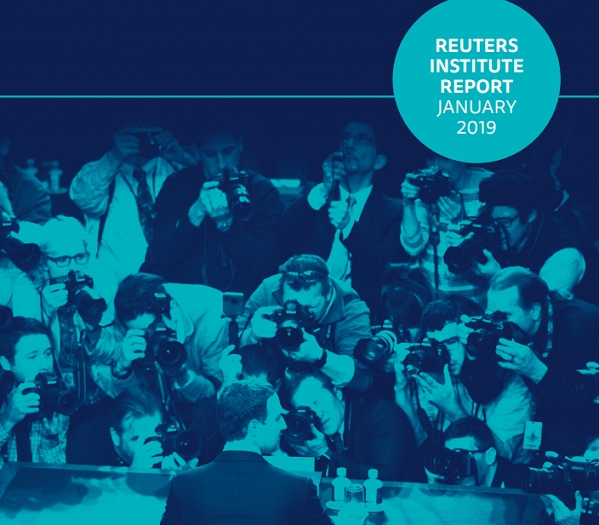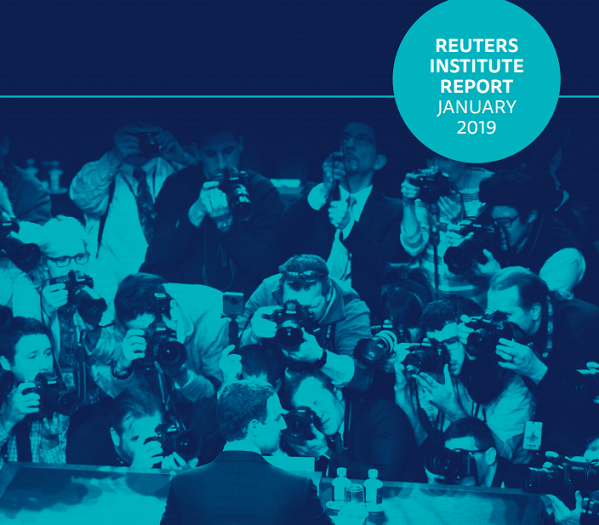
 Digital media have empowered people worldwide but also enabled the spread of disinformation and demagoguery and undermined the funding of professional journalism as we know it.
Digital media have empowered people worldwide but also enabled the spread of disinformation and demagoguery and undermined the funding of professional journalism as we know it.
People increasingly rely on search engines, social media, and messaging applications, which help them access, discuss, and share news, but also risk exposing them to false or misleading information and malicious manipulation.
Recent elections in countries as diverse as Brazil, Italy, and the United States have demonstrated the continued relevance of journalism and how digital technologies empower people, but have also revealed weaknesses in our media environment, and shown how foreign and some domestic political actors seek to exploit them. Upcoming elections in the European Union, India, and elsewhere are at risk as many of the problems we face seem to evolve faster than the solutions.
In this situation, independent professional journalism will be more important than ever in helping people understand the major challenges and opportunities facing us, from day-to-day local events to global issues. But as the business of news changes, journalism also risks becoming less robust, and ultimately incapable of helping the public make sense of our times or holding power to account.
Reporters without Borders noted that 2018 was ‘the worst year on record’ for violence against journalists, and according to Freedom House, 45% of the world’s population live in countries where the media are not free.
This report identifes fve things everybody needs to know about the future of journalism from research done at the Reuters Institute for the Study of Journalism at the University of Oxford. These fve trends will impact the work of professional reporters as well as everybody who works with them and relies on them, from the general public to politicians, NGOs, and private enterprise.
Precise developments difer from country to country, depending on the economic, political, and social context, especially as much of the world’s population is still ofine and many governments do not ensure freedom of the press, but these fve trends are global and cut across many of these diferences.
1. First, we have moved from a world where media organisations were gatekeepers to a world where media still create the news agenda, but platform companies control access to audiences.
The global move to digital, mobile, and platform-operated media means that journalism is more accessible than it has ever been. In high-income countries, more than half of all media use is now digital. More than half of digital media use is in turn mobile. And much of the time we spend with digital and mobile media is spent using products and services from platform companies like Facebook and Google. This means anyone with a smartphone and an internet connection has access to a diversity of news almost unimaginable only a few years ago. It also means that the platform companies that people rely on when navigating digital and mobile media are increasingly important for how we access and engage with news and public life.
In this ever-more competitive battle for attention, speaking is not the same as being heard, and far from the death of gatekeepers, we have seen the move to two sets of gatekeepers, where news media organisations still create the news agenda, but platform companies increasingly control access to audiences.
2. Second, this move to digital media generally does not generate flter bubbles. Instead, automated serendipity and incidental exposure drive people to more and more diverse sources of information.
While echo chambers exist, where highly motivated minorities self-select into insular news diets and like-minded communities, fears of algorithmically generated flter bubbles currently seem misplaced. While our own choices and preferences sometimes lead us to narrow information diets, technology seems to point in the opposite direction. There are opportunities here for journalists and publishers to pursue.
Empirical research thus consistently fnds that search engines and a wide range of diferent social media including both Facebook, Twitter, and YouTube demonstrably drive people to use more diferent sources of news, including more diverse sources and sources they do not seek out of their own volition (Newman et al., 2018). In practice, most people only go directly to a few news sources on a routine basis, rarely more than three or four.
For most people, digital media use is thus associated with more diverse news use, but information inequality is a real risk, as is political polarisation – risks that are fundamentally rooted in political and social factors but can be amplifed by technology.
3 .Third, journalism is ofen losing the battle for people’s attention and, in some countries, for the public’s trust.
Digital media give us access to more and more diverse information than ever before, and in this ever more intense competition for attention, journalism is at risk of losing out. While a small minority of news lovers are extremely interested in news and access news several times a day, a clear majority of the population is much less interested, and a far greater number of people access news less than once day. Segmented on the basis of interest in news and frequency of access, we can see that news lovers make up only 17% of the public, daily briefers about half (48%) and casual users, who access news less frequently than once a day, 35%. For many people, news is only a small part of their media use. In the United States, for example, data from comScore suggests only about three percent of the time we spend online is spent with news, and just half a percent with local news.
People turn of the news because it feels irrelevant and depressing and does not help them live their lives; they ofen turn to entertainment or social media instead (Tof and Nielsen, 2018). These diferences are not only a function of competition for attention. They also refect that much of the public is questioning whether journalism is in fact helping them in their lives, and that people in many countries doubt whether they can trust the news.
4. Fourth, the business models that fund news are challenged, weakening professional journalism and leaving news media more vulnerable to commercial and political pressures.
The majority of professional journalism is still funded by newspapers (Nielsen, 2016). An estimated 90% of publishers’ revenues worldwide still come from print, digital revenues are in many cases growing only slowly, and, where they exist, public service media are under considerable pressure (WAN-IFRA, 2018; see also Cornia et al., 2016; Sehl et al., 2016). Most of these existing forms of funding for professional journalism will decline as we continue to move to a more digital media environment, leading to further job cuts in newsrooms.
Historically, media organisations’ control of both content and channels meant they could count on advertising revenues being a large share of the business of news. As we have moved to a more digital, mobile, and platform-operated environment, advertisers are increasingly following audiences and spending their money elsewhere, especially with large technology companies ofering low rates, high reach, and sophisticated targeting.
We are already seeing governments across the world strategically using state advertising to infuence news media, just as some private interests are subsidising, or sometimes acquiring, news media to advance their commercial or ideological agenda (Schifrin, 2017). As independent, professional journalism provides a public good, and the market alone seems unlikely to deliver this in many cases, in countries where this could be done without giving politicians or government ofcials direct sway over news, policy intervention could be called for to address market failures (the Nordic countries provide examples of how this could be done).
5. Fifth, news is more diverse than ever, and the best journalism in many cases better than ever, taking on everyone from the most powerful politicians to the biggest private companies.
It is clear that cost-cutting, increased pressure to produce more stories across more channels/formats, and a 24/7 news cycle has led to a large volume of more superfcial journalism. But the best is better than ever. While some organisations have focused their resources and retained a commitment to accurate reporting and in-depth investigations, and recent years have seen several reminders of the power of journalistic revelations, many reporters have to produce many stories with little time, and some are lef churning out clickbait from press releases and the like (Rusbridger, 2018). Worryingly, even as many professionals working in complex organisations across business, government, and the non-proft sector specialise and know more and more about less and less, journalists are ofen forced to operate as generalists, and many know less and less about more and more.
There are more examples of inspiring innovation around the world than we can cover here, but it is worth highlighting how central digital media are to many impressive new initiatives in journalism, from the German newspaper Die Zeit’s ‘Deutschland Sprichts’, which matches readers with diferent political views for one-to-one ofine discussions, and collaborative initiatives to combat disinformation through joint fact-checking and source verifcation like the First Draf News coordinated Crosscheck in France to cross-country international investigative journalism like the ICIJ-led Panama Papers investigation (Sambrook, 2018). None of these projects would have been possible without digital media.
Journalism is facing stif competition for attention and its connection with the public is threatened by news avoidance, low trust, and the perception that news does not help people live the lives they want to live. But in many ways, the best journalism today is better than ever – more accessible, more timely, more informative, more interactive, more engaged with its audience. And the role of journalistic revelations in many diferent cases, in the #MeToo movement, in confronting corruption amongst public ofcials in countries including India, South Africa, and elsewhere, and in fuelling public debate around platform companies’ power and privacy practices and other issues in the private sector, underline the continued importance of investigative reporting.
These five trends are global and important for journalists, but also for the public that relies on journalism, and for everybody who works with journalists, from politicians and NGOs to private enterprise.
They will help defne the future of journalism – more accessible as new platform products and services from augmented reality to voice assistants grow in importance to supplement search engines and social media; less robust as old business models built in twentieth-century media environments erode in twenty-frst-century environments; more important than ever as we face complex global problems and the risks of unaccountable exercise of public or private power.
To ensure this, journalists and news media need to continue to adapt to the digital media that people all around the world are eagerly embracing at the expense of print and broadcast, and build a profession and a business ft for the future. And we need collectively to protect journalists’ right to report and freedom of the media, in recognition that, at its best, independent professional journalism creates public value, and serves the public.
Authored by Rasmus Kleis Nielsen,Director of the Reuters Institute for the Study of Journalism and Professor of Political Communication at the University of Oxford and Meera Selva, Director of the Journalist Fellowship Programme at the Reuters Institute for the Study of Journalism at the University of Oxford.
Source: Reuters Institute
